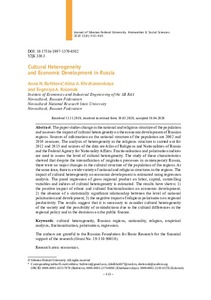Cultural Heterogeneity and Economic Development in Russia
Скачать файл:
URI (для ссылок/цитирований):
https://elib.sfu-kras.ru/handle/2311/135184Автор:
Bufetova, Anna N.
Khrzhanovskaya, Alina A.
Kolomak, Evgeniya A.
Буфетова, А.Н.
Хржановская, А.А.
Коломак, Е.А.
Дата:
2020-04Журнал:
Журнал Сибирского федерального университета. Гуманитарные науки. Journal of Siberian Federal University. Humanities & Social Sciences;2020 13 (4)Аннотация:
The paper studies change in the national and religious structure of the population
and assesses the impact of cultural heterogeneity on the economic development of Russian
regions. Sources of information on the national structure of the population are 2002 and
2010 censuses. The analysis of heterogeneity in the religious structure is carried out for
2012 and 2015 and sources of the data are Atlas of Religions and Nationalities of Russia
and the Federal Agency for Nationality Affairs. Fractionalisation and polarisation indices
are used to assess the level of cultural heterogeneity. The study of these characteristics
showed that despite the intensification of migration processes in contemporary Russia,
there were no major changes in the cultural structure of the population of the regions. At
the same time, there is a wide variety of national and religious structures in the regions. The
impact of cultural heterogeneity on economic development is estimated using regression
analysis. The panel regression of gross regional product on labor, capital, controlling
variables and indices of cultural heterogeneity is estimated. The results have shown: 1)
the positive impact of ethnic and cultural fractionalisation on economic development;
2) the absence of a statistically significant relationship between the level of national
polarisation and development; 3) the negative impact of religious polarisation on regional
productivity. The results suggest that it is necessary to consider cultural heterogeneity
of the society and the possibility of contradictions due to the cultural differences in the
regional policy and in the decisions on the public finance В статье исследуются изменения в национальной и религиозной
структуре населения и оценивается влияние культурной неоднородности
на экономическое развитие регионов России. Источниками информации о
национальной структуре населения являются переписи 2002 и 2010 годов. Анализ
неоднородности религиозной структуры проведен за 2012 и 2015 годы, источником
данных являются Атлас религий и национальностей России и Федеральное
агентство по делам национальностей. Уровень культурной гетерогенности
оценивается с помощью индексов фракционализации и поляризации. Изучение
этих характеристик показало, что, несмотря на усиление миграционных процессов
в современной России, существенных изменений в культурной неоднородности
населения не произошло. В то же время имеет место большое разнообразие
национальных и религиозных структур в регионах. Влияние культурной
неоднородности на экономическое развитие оценивается с помощью регрессионного
анализа. Оценивалась панельная регрессия ВРП на труд, капитал, контролирующие
переменные и индексы культурной неоднородности. Результаты показали:
1) положительное влияние этнокультурной фракционализации на экономическое
развитие; 2) отсутствие статистически значимой связи между уровнем национальной
поляризации и развитием; 3) негативное влияние религиозной поляризации на
продуктивность. Полученные результаты свидетельствуют о необходимости учета
культурной неоднородности общества в региональной политике и в управлении
общественными финансами

